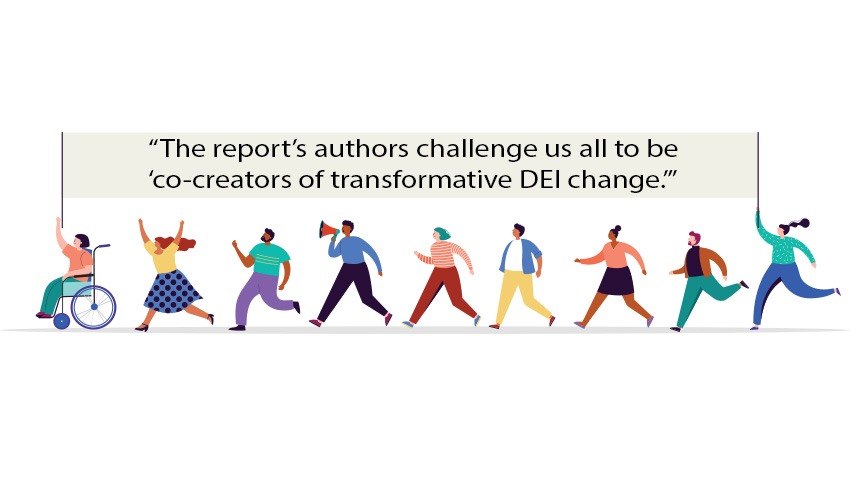A new report shows how very far we have to go with DEI
There’s this thing that’s stayed with me from a history class in college. Reality can be shapeshifting depending on where (and who) you are. The same event can be seen as something completely different, depending on your vantage point. That’s the challenge when it comes to DEI, the common shortening of diversity, equity and inclusion.
As an industry, we may think we offer a great big welcoming tent to everyone, regardless of color, creed, heritage, physical or mental condition, or personal pronoun. You may think you’re modeling and promoting a culture in your own company and at your events that shout out a DEI-positive experience.
Yet others—and most especially others “not like you”—may have very different viewpoints.
Essentially, that’s where we are as an industry, according to new research. The Events Industry Council (EIC)—you probably know them best as the CMP people—in partnership with its global EIC Equity Task Force, has released the results of its 2022 Equity Benchmarking Study. It’s “the critical first phase” of EIC’s Equity Acceleration Plan. What the survey reveals is, well, revealing: widespread DEI dissatisfaction among event professionals, minority groups and women.
This cries out for a closer look.
Under the Study’s Hood
First, a quick look at the mechanics underlying the research. EIC appointed its Equity Task Force in 2020 “to address systemic racism and all forms of discrimination in the business events and hospitality industry,” according to an EIC press release. Its 36 members are mostly drawn from the leadership tier of meeting professionals, DMOs, event venues, hospitality companies and other organizations within the meetings orbit. (Full disclosure: Marin Bright, founder and CEO of Smart Meetings, is a member of the task force.)
The study itself began with a series of leadership focus groups within the task force, the EIC board of directors, and external key stakeholders and partners, with the goal of building common understanding and ownership of the project, and to shape the design of an industry-wide benchmarking study.
Then, the chatbox survey got underway, and was responded to by 1,404 event professionals from 380 unique organizations in more than 15 industry sectors. To produce a “robust, objective assessment,” the current DEI experience in the industry was measured across four dimensions: ownership, accountability and power of influence, delivering change, and sustaining change. The overall study was managed and conducted by outside consultants over three months.
DEI Defined
Diversity: Expressed in myriad forms. See “Diversity Salad” sidebar.
Equity: Actively challenging and responding to bias, harassment and discrimination in any form and toward any person based on race, color, national origin, age, marital status, sex, sexual orientation, gender identity, gender expression, disability, religion, height, weight or veteran status.
Inclusion: Deliberate effort to ensure that differences are welcomed, different perspectives are respectfully heard and every individual feels a sense of belonging and inclusion.
Top-line Results

The survey results were unequivocal.
Employed event professionals (83% of all survey respondents) are significantly more dissatisfied with DEI in the industry than those who are self-employed or have alternative employment types.
Six in ten (61%) of all surveyed meetings professionals identified as White and are predominant across all job grades, with minimal representation from other ethnicities, especially in senior management (15% Black) and board positions (6% Black). “Unconscious biases could be limiting job progression for events professionals from different ethnicities,” the study report suggests.
Respondents who identify as Black (16%) rated their DEI experience 11% lower across all four dimensions than respondents who identified as White.
From the study’s executive summary: “The study’s findings bring to the forefront the impact of subtle forms of racism and discrimination on the DEI experience in the events industry. Often racism is synonymous with racial slurs, hate crimes and other actions. However, the difference of the DEI scores between respondents who identified as Black in comparison to those who identified as White draws attention to less obvious but equally detrimental forms of racism—structural and systemic racism.”
Read More: Diversity, Equity and Inclusion Are Good for Your Meetings (and Business)
These forms of racism, it notes, can manifest in things like project assignments, pay or benefits, performance reviews and overall career progress.
More than three-quarters of respondents identified as female, and they were well represented in managerial and senior roles. Six out of 10 female respondents (61%) are in senior management and board jobs, yet they rated their DEI experience significantly lower than male respondents (by 21%). The study report calls out “how powerful and influential the male dominance in the industry is, despite being a smaller population.”
In announcing these results, EIC sounded the alarm. “While there is an ever-growing awareness and commitment toward equity,” a press release stated, “survey scores indicate DEI efforts are largely in principle but not in practice. There is an urgent need for organizations to advance their DEI structures, policies and initiatives to deliver measurable change.”
The study report itself loudly echoes this assertion: “There is no doubt that the industry needs better representation from minority groups, professionals with different sexual orientations, various educational backgrounds, etc. However, this becomes a mere statistical activity if there is only improvement in these metrics, without improvements in the experiences of these professionals within the events industry. It is no longer just about what is done, but more about how it is done that is becoming crucial.
“More diverse professionals can be recruited, but how they are being involved to effect change will make all the difference. The industry must adopt unconventional practices and a contemporary approach to make everyone truly belong.”
Jason Dunn Sr., the task force co-chair, certainly agrees with that call to action and views it as a challenge that can be met. Dunn is the newly named executive director of the National Coalition of Black Meeting Professionals. You may know him as past chairman of that organization and as a change-maker at Visit Cincy and within the national hospitality industry for almost two decades.
“I really want people to not be fearful of the report,” he says. “I want people to think about how our industry leads the globe in several areas. If we are to be reflective of the opportunity, we have to address this within our own walls.”
As an aside, he admits disappointment there weren’t more Black respondents to the chatbox survey, but says this may be silent testimony to the magnitude of the effort that must be taken. “It was of interest who participated. And why,” as he puts it. “Our suspicion is that folks are weary of answering questions like that. Or maybe we were not asking the right people at the right time. All this will be addressed in the next steps.”
“The industry must adopt unconventional practices and a contemporary approach to make everyone truly belong.”
Dunn continues: “Dismal Black and Brown representation within the events industry presents barriers to diversity and inclusion in leadership and influential positions needed to impact change. Dispersed power and greater ownership of roles at all levels is rooted in an authentic DEI strategy, which in turn strengthens our industry’s infrastructure and positions us to compete on a global scale. Bottom line, the events industry propels the global economy, through thoughtful, high-impact events. It’s time for us to apply the same commitment, resources and metrics at an accelerated pace to intertwine DEI principles in all that we do.
Like stepping on a scale and then setting a goal, the study’s real value is not to point fingers but to demarcate a base line. “We did the benchmark to say here is what we have at the moment,” in Dunn’s words. “We have a lot of work to do that is going to require patience and grace to muscle through because it’s going to be difficult. This study gives us the starting point and framework to do that.”
Dunn says the process of addressing DEI in our organizations and work begins with “what DEI is, and how you define it. For many, what gets you to the table is race. And that’s often an uncomfortable conversation. But there are so many other aspects to this: not only race but gender, disabilities and so on. You first have to agree on the definition, then have the power or influence within your organization to determine how the definition pertains to you and how you will act on it. It has to come from the top. Then have an honest conversation about how you move forward.”
“This is an uncomfortable conversation,” he concedes. “You have to be vulnerable. But I do believe the climate is changing to where people are really looking at themselves inwardly. The globe is becoming more diverse. If people want to remain relevant, to compete, they have to adjust to the current population. It’s browning. It’s not as it was 40-50 years ago.”
The business case for enhanced DEI, he concludes, is obvious. “People are going to be encouraged by their bottom line, by the ability to retain talent, to be more inclusive,” he says, “providing equality so folks will want to belong. It’s an exciting opportunity for ost.”
What You Can Do
The study report sees progress as well as challenge. “It is evident,” it states, “that the Black Lives Matter movement has driven people in positions of power to step up and make their workplaces fairer and more inclusive. Leaders and people across organizations are now more aware of these issues and keener to play an active role to help their marginalized colleagues advance rather than expect any single function (such as human resources or a DEI committee) to make all the difference.”
The report’s authors challenge us all in the industry to be “co-creators of transformative DEI change.” This means everyone “must educate themselves about racism, be more cognizant of privilege, take responsibility for their own behaviors, and receive feedback from people in underrepresented groups. In other words, each one of us must ‘be an ally.’
“A crucial component in being an ally is to call out or confront unconscious bias and systematic oppression based on race, religion, gender, religion, sexual orientation or ability. Effective allyship could involve recognizing one’s own privilege and using it to influence inclusion and equity. To enable a culture of allyship in the events industry, all stakeholders must advocate for each other and stand together against bias, discrimination and racism.”

Next Steps
“Our task force is committed to addressing these survey findings with actionable and measurable solutions,” Dunn promises. “The journey won’t be easy, but nothing worth having ever is.”
The benchmarking study is the first phase of a multi-year initiative to accelerate meaningful action on DEI across the global business events industry. Phase Two of EIC’s Equity Acceleration Plan includes a leadership workshop to review the study and come to a shared understanding of its implications for EIC’s work in this area.
Dunn’s leadership partner on the task force, Tina Wehmeir, AMC Institute president and CEO, says this phase will focus on the first two dimensions of the DEI experience: ownership and accountability/power of influence. “To create a sustainable environment of change, we must foster a sense of ownership among everyone,” Wehmeir says. These first two dimensions represent “a particularly critical area based on our survey finding that minority groups showed higher levels of dissatisfaction in larger organizations. This further illustrates the need for organizational leadership to connect DEI principals to actual outcomes. It also reaffirms the importance of assembling the men and women of the EIC Task Force. They are change agents.”
Ultimately, the task force’s brief is to build “a pan-industry strategic plan, along with frameworks, voluntary guidelines, and toolkits to help member organizations identify and address deep-rooted DEI issues, focus on priority actions and sustain necessary changes.”
With EIC’s more than 30 member organizations representing over 103,500 individuals and 19,500 firms and properties involved in the meetings industry, that would go a long way toward redressing the longstanding imbalance and injustices in an industry that’s all about creating a better world.
Diversity Salad
Nationally recognized DEI expert Kelly McDonald (author of It’s Time to Talk About Race at Work and How to Work With and Lead People Not Like You) sees America not as a melting pot but “a salad bowl with distinct ingredients combining into something great.”
Diversity has long been thought of primarily in terms of race and gender, but her list is waaaay more inclusive.
To wit: race (including linguistic and ethnic differences), gender, sexual identity, religious beliefs (or lack thereof), age and generation, physical abilities, rural vs. metro, political beliefs, military vs. civilian, nativity (native vs. foreign born), life stage (e.g., new mom, retiree), lifestyle and affluence, core values (vegan, homeschooler, environmentalist), diversity within diversity (e.g., Asians’ many cultures, languages, separate traditions and holidays).
Why does difference matter? She points out that in the United States, one in nine people is now foreign-born. We are also the world’s second-largest Hispanic country—there are more people of Hispanic origin here than Canadians in Canada. And for the first time, workforce composition is equally divided between men and women. That is worth talking about.
A DEI Event Planning Checklist
Pre-Event
Event team: Include diverse perspectives by including diverse representatives and/or soliciting DEI feedback during the planning process.
Event budget: Ensure your budget factors in costs for accessibility needs and inclusive catering options.
Agenda creation: Actively consider possible DEI-related topics that could be incorporated into the agenda or could be addressed through DEI-related questions as part of panels or keynotes.
Moderator/speaker invitation: Include language on particular DEI-related issues you would like to address to gauge comfort levels and fit.
Date, catering, and venue selection: Avoid religious and cultural days of observance. Solicit diverse and locally owned caterers and venues which accommodate accessibility needs (e.g., elevator access, ADA restrooms, accessible entrances without stairs or steps, ramps, wheelchair/low vision/low hearing seating, clear and legible signs). Ensure venue has all-gendered restrooms or is open to designating specific restrooms as gender neutral. Ensure venue has the option to set up designated rooms as needed—lactation room, prayer room, quiet room, etc.
Event promotion and registration: Ensure event promotion language and visuals are inclusive for target audiences. Include questions about dietary and accessibility needs in registration form. Includes option to enter gender pronouns on registration form for inclusion on attendee nametags.
Moderator prep: Prepare moderator(s) with panelist identification information and DEI-related questions. Pre-plan how moderator(s) prefer to solicit questions/feedback from audiences in order to ensure that underrepresented perspectives are included. Ensure moderators are prepared to handle sensitive subjects (related to race, gender, orientation, ability, etc.) that may arise in discussions.
Accessibility needs: When needed, hire sign language services or offer assistive learning devices (ALD) or closed captions. Reconfirm physical access and elevator function with venue.
Food prep: Offer kosher, halal, vegetarian, vegan, dairy-free and gluten-free options as needed, and clearly label any buffet-style meals.
Pre-event communication: Provide all guests with a guided map to note accessibility entrances/exits for the venue during the event.
At Event
Make sure registration tables, signs and materials are easily accessible and readable to attendees with disabilities. Post signage at registration if any portion of the event is being recorded. During the program, have designated reserved seating available for anyone who may need or request it day-of, being mindful of space and ease of accessibility for those in need (pregnant, disabled, elderly, etc.).
Post-event
In the post-event survey, ask about inclusion and accessibility at the event.
Adapted from a Columbia Business School DEI Planning Checklist.
This article appears in the January/February 2023 issue. You can subscribe to the magazine here.




